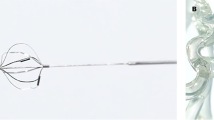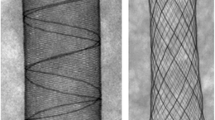Abstract
Purpose
In recent years, flow diverters have provided a promising alternative to treat complex intracranial aneurysms. In this study, we compare a second-generation flow-diverting device (Derivo Embolization Device) with its prototype flow diverter, in the treatment of elastase-induced aneurysms in New Zealand white rabbits.
Methods
The Derivo Embolization Device is a self-expanding stent consisting of 48 nitinol wires. The device was implanted across the necks of 17 elastase-induced aneurysms in New Zealand white rabbits. One additional device was implanted in the abdominal aorta of each animal covering the origin of lumbar arteries. Follow-up was performed after 3 months (n = 8) and 6 months (n = 9) under continuous double antiplatelet therapy. Statuses of angiographic and histological aneurysm occlusion as well as patency of branch arteries and neointimal growth were evaluated and compared with its prototype flow diverter.
Results
The Derivo Embolization Device provided advanced visibility and flexibility, which led to more accurate navigation and placement. Complete aneurysm occlusion rates were noted in 15 cases (88 %), respectively, compared with 5 cases (28 %) with the first-generation device (p = 0.001). Neointimal growth and diameter stenosis were significantly less with the Derivo Embolization Device and declining after 6 months follow-up in the abdominal aorta. Extreme device oversizing led to distal occlusion of the parent vessel in three cases. Covered branch arteries remained patent throughout the entire period of observation.
Conclusions
The Derivo Embolization Device provides excellent occlusion of elastase-induced aneurysms while preserving branch arteries.





Similar content being viewed by others
Abbreviations
- FRED:
-
Flow Re-Direction Endoluminal Device
- FD:
-
Flow Diverter
- DSA:
-
Digital Subtraction Angiography
- AA:
-
Abdominal Aorta
- SA:
-
Subclavian Artery
- BT:
-
Brachiocephalic Trunk
- ICA:
-
Internal Carotid Artery
- PED:
-
Pipeline Embolization Device
- SFD:
-
SILK Flow Diverter
References
Kallmes DF, Ding Y-H, Dai D, Kadirvel R, Lewis DA, Cloft HJ. A new endoluminal, flow-disrupting device for treatment of saccular aneurysms. Stroke. 2007;38(8):2346–52.
Kallmes DF, Ding YH, Dai D, Kadirvel R, Lewis DA, Cloft HJ. A second-generation, endoluminal, flow-disrupting device for treatment of saccular aneurysms. AJNR Am J Neuroradiol. 2009;30:1153–8.
Sadasivan C, Cesar L, Seong J, Rakian A, Hao Q, Tio FO, Wakhloo AK, Lieber BB. An original flow diversion device for the treatment of intracranial aneurysms: evaluation in the rabbit elastase-induced model. Stroke. 2009;40(3):952–8.
Saatci I, Yavuz K, Ozer C, Geyik S, Cekirge HS. Treatment of intracranial aneurysms using the pipeline flow-diverter embolization device: a single-center experience with long-term follow-up results. AJNR Am J Neuroradiol. 2012;33(8):1436–46.
Berge J, Biondi A, Machi P, Brunel H, Pierot L, Gabrillargues J, Kadziolka K, Barreau X, Dousset V, Bonafé A. Flow-diverter silk stent for the treatment of intracranial aneurysms: 1-year follow-up in a multicenter study. AJNR Am J Neuroradiol. 2012;33(6):1150–5.
Becske T, Kallmes DF, Saatci I, McDougall CG, Szikora I, Lanzino G, Moran CJ, Woo HH, Lopes DK, Berez AL, Cher DJ, Siddiqui AH, Levy EI, Albuquerque FC, Fiorella DJ, Berentei Z, Marosfoi M, Cekirge SH, Nelson PK. Pipeline for uncoilable or failed aneurysms: results from a multicenter clinical trial. Radiology. 2013;267(3):858–68.
Puffer RC, Piano M, Lanzino G, Valvassori L, Kallmes DF, Quilici L, Cloft HJ, Boccardi E. Treatment of cavernous sinus aneurysms with flow diversion: results in 44 patients. AJNR Am J Neuroradiol. 2014;35:948–51.
Diaz O, Gist TL, Manjarez G, Orozco F, Almeida R. Treatment of 14 intracranial aneurysms with the FRED system. J Neurointerv Surg. 2013;0:1–4.
Murthy SB, Shah S, Venkatasubba Rao CP, Bershad EM, Suarez JI. Treatment of unruptured intracranial aneurysms with the pipeline embolization device. J Clin Neurosci. 2014;21(1):6–11.
Kulcsár Z, Ernemann U, Wetzel SG, Bock A, Goericke S, Panagiotopoulos V, Forsting M, Ruefenacht DA, Wanke I. High-profile flow diverter (silk) implantation in the basilar artery: efficacy in the treatment of aneurysms and the role of the perforators. Stroke. 2010;41(8):1690–6.
van Rooij WJ, Sluzewski M. Perforator infarction after placement of a pipeline flow-diverting stent for an unruptured A1 aneurysm. AJNR Am J Neuroradiol. 2010;31(4):E43–4.
Maimon S, Gonen L, Nossek E, Strauss I, Levite R, Ram Z. Treatment of intra-cranial aneurysms with the SILK flow diverter: 2 years’ experience with 28 patients at a single center. Acta Neurochir (Wein). 2012;154(6):979–87.
Tan LA, Keigher KM, Munich SA, Moftakhar R, Lopes DK. Thromboembolic complications with Pipeline Embolization Device placement: impact of procedure time, number of stents and pre-procedure P2Y12 reaction unit (PRU) value. J Neurointerv Surg. 2015;7(3):217–21.
Murthy SB, Shah S, Shastri A, Venkatasubba Rao CP, Bershad EM, Suarez JI. The SILK flow diverter in the treatment of intracranial aneurysms. J Clin Neurosci. 2014;21(2):203–6.
Kulcsár Z, Houdart E, Bonafé A, Parker G, Millar J, Goddard AJ, Renowden S, Gál G, Turowski B, Mitchell K, Gray F, Rodriguez M, van den Berg R, Gruber A, Desal H, Wanke I, Rüfenacht DA. Intra-aneurysmal thrombosis as a possible cause of delayed aneurysm rupture after flow-diversion treatment. AJNR Am J Neuroradiol. 2011;32(1):20–5.
Turowski B, Macht S, Kulcsár Z, Hänggi D, Stummer W. Early fatal hemorrhage after endovascular cerebral aneurysm treatment with a flow diverter (SILK-Stent): do we need to rethink our concepts? Neuroradiology. 2011;53(1):37–41.
Cebral JR, Mut F, Raschi M, Scrivano E, Ceratto R, Lylyk P, Putman CM. Aneurysm rupture following treatment with flow-diverting stents: computational hemodynamics analysis of treatment. AJNR Am J Neuroradiol. 2011;32(1):27–33.
Hampton T, Walsh D, Tolias C, Fiorella D. Mural destabilization after aneurysm treatment with a flow-diverting device: a report of two cases. J Neurointerv Surg. 2011;3(2):167–71.
Clarençon F, Di Maria F, Biondi A, Chiras J, Sourour NA. Distant and delayed (> 7 days) hemorrhage after treatment by flow-diverter stents in intracranial aneurysms: a rare but potentially serious complication. AJNR Am J Neuroradiol. 2013;34(7):E81–2.
Darsaut TE, Rayner-Hartley E, Makoyeva A, Salazkin I, Berthelet F, Raymond J. Aneurysm rupture after endovascular flow diversion: the possible role of persistent flows through the transition zone associated with device deformation. Interv Neuroradiol. 2013;19(2):180–5.
Tomas C, Benaissa A, Herbreteau D, Kadziolka K, Pierot L. Delayed ipsilateral parenchymal hemorrhage following treatment of intracranial aneurysms with flow diverter. Neuroradiology. 2014;56(2):155–61.
Fiorella D, Hsu D, Woo HH, Tarr RW, Nelson PK. Very late thrombosis of a pipeline embolization device construct. Neurosurgery. 2010;67:onsE313–4.
Fischer S, Vajda Z, Aguilar Perez M, Schmid E, Hopf N, Bäzner H, Henkes H. Pipeline embolization device (PED) for neurovascular reconstruction: initial experience in the treatment of 101 intracranial aneurysms and dissections. Neuroradiology. 2012;54(4):369–82.
Cohen JE, Gomori JM, Moscovici S, Leker RR, Itshayek E. Delayed complications after flow-diverter stenting: reactive in-stent stenosis and creeping stents. J Clin Neurosci. 2014;21:1116–22.
Simgen A, Ley D, Roth C, Yilmaz U, Körner H, Mühl-Benninghaus R, Kim YJ, Scheller B, Reith W. Evaluation of a newly designed flow diverter for the treatment of intracranial aneurysms in an elastase-induced aneurysm model, in New Zealand white rabbits. Neuroradiology. 2014;56(2):129–37.
Cloft HJ, Altes TA, Marx WF, Raible RJ, Hudson SB, Helm GA, Mandell JW, Jensen ME, Dion JE, Kallmes DF. Endovascular creation of an in vivo bifurcation aneurysm model in rabbits. Radiology. 1999;213(1):223–8.
Kamran M, Yarnold J, Grunwald IQ, Byrne JV. Assessment of angiographic outcomes after flow diversion treatment of intracranial aneurysms: a new grading schema. Neuroradiology. 2011;53(7):501–8.
Cremers B, Kelsch B, Clever YP, Hattangadi N, Mahnkopf D, Speck U, Taupitz M, Scheller B. Inhibition of neointimal proliferation after bare metal stent implantation with low-pressure drug delivery using a paclitaxel-coated balloon in porcine coronary arteries. Clin Res Cardiol. 2012;101(5):385–91.
Briganti F, Napoli M, Tortora F, Solari D, Bergui M, Boccardi E, Cagliari E, Castellan L, Causin F, Ciceri E, Cirillo L, De Blasi R, Delehaye L, Di Paola F, Fontana A, Gasparotti R, Guidetti G, Divenuto I, Iannucci G, Isalberti M, Leonardi M, Lupo F, Mangiafico S, Manto A, Menozzi R, Muto M, Nuzzi NP, Papa R, Petralia B, Piano M, Resta M, Padolecchia R, Saletti A, Sirabella G, Bolgè LP. Italian multicenter experience with flow-diverter devices for intracranial unruptured aneurysm treatment with periprocedural complications—a retrospective data analysis. Neuroradiology. 2012;54(10):1145–52.
Gross BA, Frerichs KU. Stent usage in the treatment of intracranial aneurysms: past, present and future. J Neurol Neurosurg Psychiatry. 2013;84(3):244–53.
Asakura M, Ueda Y, Nanto S, Hirayama A, Adachi T, Kitakaze M, Hori M, Kodama K. Remodeling of in-stent neointima, which became thinner and transparent over 3 years: serial angiographic and angioscopic follow-up. Circulation. 1998;97(20):2003–6.
Dai D, Ding YH, Kadirvel R, Rad AE, Lewis DA, Kallmes DF. Patency of branches after coverage with multiple telescoping flow-diverter devices: an in vivo study in rabbits. AJNR Am J Neuroradiol. 2012;33(1):171–4.
Dai D, Ding YH, Kadirvel R, Lewis DA, Cloft HJ, Kallmes DF. Bone formation in elastase-induced rabbit aneurysms embolized with platinum coils: report of 2 cases. AJNR Am J Neuroradiol. 2007;28(6):1176–8.
Girdhar G, Li J, Kostousov L, Wainwright J, Chandler WL. In-vitro thrombogenicity assessment of flow diversion and aneurysm bridging devices. J Thromb Thrombolysis. 2015;40(4):437–43.
Chappé J-M, Martin N, Lintymer J, Sthal F, Terwagne G, Takadoum J. Titanium oxynitride thin films sputter deposited by the reactive gas pulsing process. Appl Surf Sci. 2007;253:5312–6.
Kocer N, Islak C, Kizilkilic O, Kocak B, Saglam M, Tureci E. Flow Re-direction Endoluminal Device in treatment of cerebral aneurysms: initial experience with short-term follow-up results. J Neurosurg. 2014;120(5):1158–71.
Pereira VM, Kelly M, Vega P, Murias E, Yilmaz H, Erceg G, Pellaton A, Lovblad KO, Krings T. New Pipeline Flex device: initial experience and technical nuances. J Neurointerv Surg. 2015;7(12):920–5.
Briganti F, Leone G, Marseglia M, Cicala D, Caranci F, Maiuri F. p64 flow modulation device in the treatment of intracranial aneurysms: initial experience and technical aspects. J Neurointerv Surg. 2015 Apr 20. [Epub ahead of print]
Acknowledgments
This study was supported in part by a research grant of the BMWi (German Ministry of Economic Affairs and Energy, Grant number: KF2335801WL9).
We would like to thank the Head of the Department of Experimental Surgery, Prof. Menger, and his team for supporting this study.
Ethical Standards
We declare that our animal studies have been approved by the (ethics committee of the Saarland University) and have therefore been performed in accordance with the ethical standards laid down in the 1964 Declaration of Helsinki and its later amendments.
Publication
Parts of this study have been published as an oral poster presentation at the meeting of the German society of neuroradiology (DGNR) in Cologne, Germany in October 2013 and as an oral presentation at the 20th Symposium Neuroradiologicum Istanbul, Turkey in September 2014.
Conflict of Interest
This study was funded by Acandis GmbH, Pforzheim, Germany. Giorgio Franco Maria Cattaneo and Werner Mailänder, engineers at the company, served as proctors during this study.
Author information
Authors and Affiliations
Corresponding author
Rights and permissions
About this article
Cite this article
Ley, D., Mühl-Benninghaus, R., Yilmaz, U. et al. The Derivo Embolization Device, a Second-Generation Flow Diverter for the Treatment of Intracranial Aneurysms, Evaluated in an Elastase-Induced Aneurysm Model. Clin Neuroradiol 27, 335–343 (2017). https://doi.org/10.1007/s00062-015-0493-9
Received:
Accepted:
Published:
Issue Date:
DOI: https://doi.org/10.1007/s00062-015-0493-9




